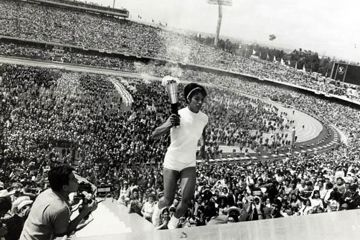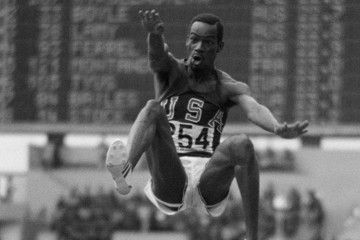Dick Fosbury in the high jump at the 1968 Olympic Games in Mexico City (© AFP / Getty Images)
In the public imagination, Sunday 20 October 1968 is the day that high jumping changed forever.
Dick Fosbury, then a 21-year-old Oregon State University student, used his new and innovative technique of jumping – a back-layout style he had dubbed the Fosbury Flop in a newspaper interview – to take the gold medal at the Mexico City 1968 Olympic Games and, into the bargain, the world was entranced.
The truth was that Fosbury had been using his style since the spring of 1963, when he was a high school student, and a few other jumpers had also been experimenting with going over the bar head first, notably Canada’s future Commonwealth Games champion Debbie Brill, helped by advances in landing pits to much safer all-foam beds.
Into the bargain, pictures of Fosbury in action had been sent around the world by wire services as early as 1964 when he first started having some success with his almost-unique style.
But most of the world wasn’t aware of developments over the previous five years and on the final day of the athletics programme in the packed Estadio Olimpico Universitario, it was as if Fosbury had just turned up in the Mexican capital and decided to tear up the existing coaching manuals.
Fosbury’s performance with him clinching the gold medal with a clearance on his third and final attempt at an Olympic and US record of 2.24m was utterly revolutionary. That was the day, in the eyes of many, that the event changed forever.
To quote from a 1980 book by the reputed US high jump coach John Tansley, “Few athletes in history have done their thing as uniquely as Dick Fosbury. He literally turned his event upside down.”
The world record-holder Valery Brumel – perhaps in a mixture of pique at being unable to defend his Olympic title from 1964 after a serious motorbike accident the following year, or maybe seeing somebody who could threaten his world record of 2.28m that had been set 1963, or perhaps getting caught up in some cold war propaganda – was quoted in Soviet newspapers at the time as calling Fosbury’s style “an aberration” but he soon changed his mind after the world quickly started to embrace the new style.
Fosbury had gone to Mexico City as a definite medal contender but hardly the favourite. At the US Olympic Trials in Echo Summit, Fosbury had to settle for third place, after having won an earlier US trial in Los Angeles whose result was later annulled – but it was enough to punch his ticket to Mexico City the following month.
“Fosbury is up against the toughest field ever assembled to do battle for the Olympic title,” wrote Jon Hendershott in Track and Field News’ Olympic preview issue.
The competition in Mexico City was to fulfil Hendershott’s prophecy.
When the bar was raised to 2.18m, five men were still in the contest. Fosbury, as he had done at his earlier heights, went over at the first time of asking. His team mate Ed Caruthers managed that height on his third attempt while the third USA team member 17-year-old Reynaldo Brown and the USSR’s Valery Skvortsov both failed three times. USSR’s Valentin Gavrilov – who had taken over as the Soviet Union’s leading jumper in the post-Brumel era – gambled and passed that height.
At 2.20m all three remaining jumpers went over on their first attempts, Gavrilov maintaining his flawless record in the competition. The bar then went up to 2.22m with the trio each assured of a medal but not a specific colour.
Fosbury cleared cleanly again with his first jump, without even nudging the bar, Caruthers managed it with his second effort but Gavrilov couldn’t negotiate that height and was eliminated with the bronze medal in his grasp. At 2.24m, a US and Olympic record and a height only two men in the world had ever exceeded at the time, Fosbury had his first failures of the competition taking the bar off twice, but so too did Caruthers.
On his third attempt, Fosbury went over with a good inch or more of daylight between himself and the metal bar and the captivated crowd which had been cheering him since the early heights went wild.
However, Fosbury showed little emotion as he climbed off the mat, despite the records he had just accrued. Caruthers was still to jump but the Oklahoman wearily brought the bar down for a third and final time and the gold went to the man from Oregon.
Fosbury then had the bar raised to a world record height 2.29m – a full two inches in imperial measurement – but finally it was a bar too high for Fosbury and, mentally spent, he had three lacklustre attempts.
In the wake of his success, Fosbury was being widely touted as the next world record holder, especially given the way he had cleared 2.24m.
In early 1969, the British athletics writer Bob Phillips commented: ”Fosbury stands alone as the one man capable of improving on the Russian’s world record.” It wasn’t to be. What Phillips and much of the world didn’t know was that Fosbury had been given a stark choice at his university between focussing on his civil engineering studies or high jumping, and he opted for the former.
Fosbury never jumped higher than he jumped in Mexico City and it was to be another three years before there was an improvement in the world record, with fellow American and straddler Pat Matzdorf clearing 2.29m in July 1971.
However, that one afternoon in Mexico City made an indelible impression on the world, not least on a 14-year-old living in California called Dwight Stones.
Five years later Stones became the first world record holder to use Fosbury’s technique, clearing 2.30m to add a centimetre to Matzdorf’s mark two earlier.
The speed with which the Fosbury Flop took over as the predominant high jump technique was rapid, surprising even Fosbury himself. By the next Olympics in 1972, 28 of the 40 competitors were using his style.
“I thought that after I won the gold, one or two jumpers would start using it, but I never really contemplated that it would become the universal technique," Fosbury said in 2012. "Yet, it only took a generation.
"The last staddle jumper at the Olympics was in Seoul (in 1988). It took a little time for European coaches to start teaching it as they had only seen still photos and couldn’t understand running around a curve, but it was still a surprise to me what happened."
Phil Minshull for the IAAF






